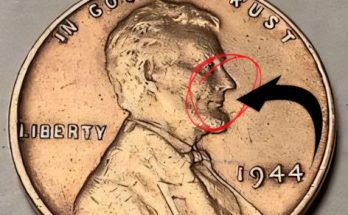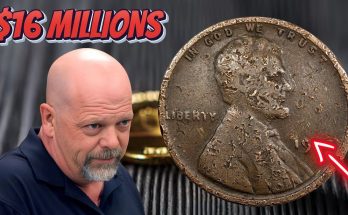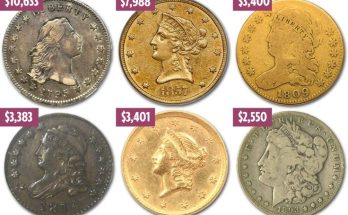 The War-Era Nickel: A $10 Million Numismatic Enigma
The War-Era Nickel: A $10 Million Numismatic Enigma
The image captures the reverse of a Jefferson Nickel, specifically highlighting the architectural rendering of Monticello, Thomas Jefferson’s iconic home. Surrounding it are the inscriptions “E PLURIBUS UNUM,” “MONTICELLO,” “FIVE CENTS,” and “UNITED STATES OF AMERICA.” The photograph is designed to evoke sensationalism, claiming that a particular variation of this coin could be worth an astonishing $10 million. While the specific Jefferson Nickel shown, a “War Nickel,” is indeed a fascinating and valuable piece of U.S. coinage history, the ten million dollar figure is more likely associated with a different, but similarly famous, minting error from the same year—the legendary 1943 Copper Lincoln Penny.
 The War Nickel’s Historical Significance
The War Nickel’s Historical Significance
The Jefferson War Nickel refers to the coins minted between 1942 and 1945. The dramatic change in the coin’s composition was a direct consequence of the United States’ involvement in World War II.
The Call for Conservation
The standard five-cent coin, introduced in 1938, was made of an alloy that was 75% copper and 25% nickel. However, as the war effort intensified, both copper and nickel became critical strategic metals required for manufacturing essential military supplies, such as shell casings and armor plating. To conserve these vital resources, the U.S. Congress authorized the Mint to temporarily change the composition of the nickel.
A Silver Solution
The resulting wartime alloy consisted of 56% copper, 35% silver, and 9% manganese. The shift to this composition began partway through 1942 and continued through 1945. These “War Nickels” are easily identifiable by two key features:
-
Composition: They possess a distinctive slightly duller, sometimes darker, gray appearance due to the silver content.
-
Mint Mark: To easily distinguish them from the pre- and post-war issues (and simplify the process of reclaiming the silver after the war), a large mint mark (P, D, or S) was placed directly above Monticello on the reverse of the coin. This placement of the mint mark for the Philadelphia Mint (“P”) was unique in U.S. coinage at the time, as traditionally, the Philadelphia Mint did not use a mint mark.
While these silver-content nickels are sought after and worth more than their face value—typically a few dollars, or more in uncirculated grades—they do not reach the millions of dollars implied by the image.
 The Real $10 Million Error Coin
The Real $10 Million Error Coin
The immense nine-figure value often attached to a “wartime coin” is instead correctly linked to the 1943 Copper Lincoln Penny. This coin represents a catastrophic minting error that resulted in one of the rarest and most expensive error coins in American numismatics.
A Mistake Worth Millions
Like the nickel, the copper in the one-cent coin was also needed for the war. In 1943, the Mint switched the penny’s composition from the traditional bronze alloy (mostly copper) to zinc-coated steel, giving them a silvery-gray appearance.
The few 1943 pennies accidentally struck on leftover bronze planchets from 1942 are the true treasures.
-
Only an estimated 40 genuine examples of the 1943 Copper Cent are known to exist across all mints (Philadelphia, Denver, and San Francisco).
-
One of the rarest examples, a 1943-D Copper Penny, sold for a record-breaking $1.75 million in 2010.
-
The Professional Coin Grading Service (PCGS) price guide values the 1943 and 1943-S copper pennies at $1 million each, and the 1943-D at $1.5 million, making the sensational “ten million” a significant exaggeration, but one that points to a genuine, million-dollar rarity.
How to Tell the Difference
Because of its extraordinary value, the 1943 Copper Cent is often counterfeited. The simplest test is the magnet test:
-
Genuine 1943 Steel Penny: Will stick to a magnet.
-
Genuine 1943 Copper Penny: Will not stick to a magnet.
The War Nickels and the 1943 Copper Pennies stand as remarkable, tangible artifacts of American ingenuity and conservation during a pivotal moment in history. The nickels are a testament to material substitution, and the pennies are a stunning example of a minting mistake that became a numismatic legend.



